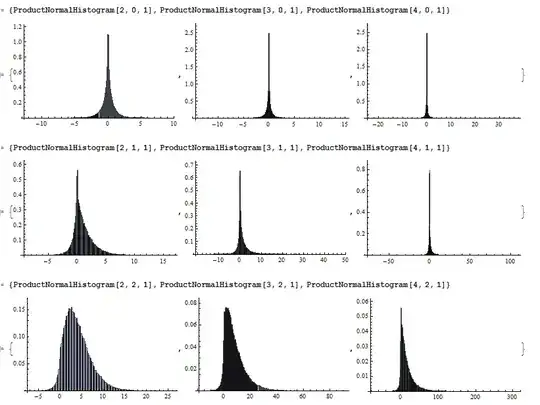Say you have $k$ i.i.d. normal random variables with some mean $\mu$ and variance $\sigma^2$ and you multiply them all together. What is the density function of the result?
-
Did you try with $k=2$ and the random variable have mean $0$, variance $1$? – Davide Giraudo Apr 19 '12 at 14:41
-
For the general $n$ case this is related to the sum of lognormal variables, which is a known difficult problem. – kjetil b halvorsen Oct 03 '17 at 09:39
2 Answers
Let $X_k = Z_1 Z_2 \cdots Z_k$, where $Z_i$ are iid normal r.v. with mean $\mu$ and variance $\sigma^2$. The precise density would be hard to come by, but moments are easy to compute: $$ \mathbb{E}(X_k^r) = \mathbb{E}(Z_1^r) \mathbb{E}(Z_2^r) \cdots \mathbb{E}(Z_k^r) = \left(m_r(Z)\right)^k $$
Here is some simulation in Mathematica:
ProductNormalHistogram[k_Integer?Positive, \[Mu]_, \[Sigma]_] :=
Block[{x},
Histogram[
RandomVariate[
TransformedDistribution[Array[x, k, 1, Times],
Array[x, k] \[Distributed]
ProductDistribution[{NormalDistribution[\[Mu], \[Sigma]
], k}]], 10^5], Automatic, "PDF", ImageSize -> 250]]

For the case of $\mu=0$ and $\sigma = 1$, look-up product-normal distribution for some analytic results.
- 70,631
I think this paper would interest you:
The Distribution of Products of Beta, Gamma and Gaussian Random Variables
M. D. Springer and W. E. Thompson
SIAM Journal on Applied Mathematics , Vol. 18, No. 4 (Jun., 1970), pp. 721-737Published by: Society for Industrial and Applied Mathematics
Article Stable URL: http://www.jstor.org/stable/2099424
Hint--Elementary(!)
Prove that:
For continuous random variables $X$ and $Y$ with joint density $f$, the density of $Z=XY$ is given by $$f_Z(z)=\int_{-\infty}^\infty \frac 1 {|x|} f\left(x,\frac z x\right) \mathrm{d} x$$
Can you generalize this to $k$ of them by induction?
But, for me this looks like a far fetched idea in that, this is more elementary. (I have never had to bother about more than $2$ for computing by hand.)
-
This would probably take me about a week, not being a good mathematician - but I will do it! For now, could you tell me approximately what shape the result would have? – Marius Kempe Apr 19 '12 at 15:15
-
The result would leave you with a $\int\int\underbrace{\cdots}\int$ after changing the order of integration using Fubini...there would be $k$ integrals I guess. – Apr 19 '12 at 15:22
-
Oh, I meant the visual shape of the resulting pdf when plotted. :-) – Marius Kempe Apr 19 '12 at 15:24
-
-